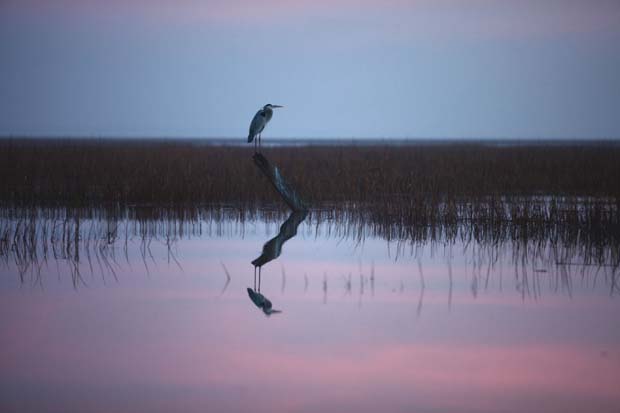Conservation groups say new regulations endanger Georgia’s salt marshes
By Associated Press / Wed, Apr 23, 2014
SAVANNAH, Georgia
[dropcap]T[/dropcap]he state Environmental Protection Division will no longer require developers to keep a 25-foot construction buffer from the edge of some coastal salt marshes, and the decision has Georgia conservation groups in an uproar.Judson Turner, the agency’s director, issued a memo Tuesday saying waterfront homes and other developments built next to a marsh will have to maintain a buffer only if there’s evidence on the banks of “wrested” vegetation — plants and grasses that have been flattened or twisted by flowing water. He cited language in Georgia’s Erosion and Sedimentation Act.

Sea Island Marsh. About 379,000 acres of salt marshes cover Georgia’s shoreline, providing habitat for fish, migratory birds and other wildlife. Photo credit Joe Rada / Sea Island Life Magazine.
Georgia previously prohibited construction at the edge of salt marshes to protect them from pollution. Turner’s predecessor as EPD director, Carol Couch, required buffers based on another law, the Coastal Marshlands Protection Act, that uses the presence of certain plants to define where the marsh ends and the uplands begin.
Angry environmentalists noted Turner issued his memo on Earth Day. They say the change essentially guts protections for the roughly 300,000 acres of marsh along the 100-mile Georgia coast. That’s about a third of the marsh on the East Coast.
Megan Desrosiers, executive director of the coastal Georgia conservation group One Hundred Miles, called the decision “a direct assault on coastal Georgia.” Steve Caley, an Atlanta-based attorney for the environmental law firm GreenLaw, said EPD had effectively announced it “will no longer protect hundreds of miles and thousands of acres of invaluable salt marsh.”
But Turner said he doesn’t believe his directive eliminated marsh buffers “across the board.”
“Ultimately, it’s saying there’s still a buffer,” Turner told the Savannah Morning News. “But where there’s no wrested vegetation, there’s not going to be a buffer.”
Marshes form a critical part of the food chain that allows fish, shrimp and crabs to thrive. They also filter sediments and pollutants from stormwater that runs off the land into streams, and serve as a protective barrier from the walls of water pushed onto land as storm surge by hurricanes.
“The last thing we want is for folks to go and build their house on the edge of the marsh and have a hurricane or big storm come and wash those houses away,” said Bill Sapp, an attorney for the Southern Environmental Law Center.
Turner said his memo simply clarifies what’s already in the law and gives his agency firmer footing to enforce it.
He said the legislature may need to revise the state law if Georgians fear the marshes aren’t getting adequate protection.
“If this wrested vegetation language doesn’t perform like we want on the coast, if it isn’t protective, the way to fix it isn’t a memo,” Turner said. “We need legislative attention.”


